< < <
PORTRAIT PAINTINGS AND MORE
My last decade has been one of adjusting to a very changed world. We
have flat panel tv's a million video channels, a thousand social media
sites, and in general we are in a very electronic world. Real art
painted with paint onto canvas is almost a museum item, just like
antiques. Although I have adapted to the internet - I was among the
first, learing to write html code already at Netscape 2 in 1998, to put
myself on the worldwide stage. The trouble is that I do not have an
electronic product like a video, and my paintings or prints are
physical items that people tend to want to see. (If someone is
interested in a painting shown on a web page like this, I can, however
discuss the painting via email, and take snapshots of it in
realistic settings, and even in closeup, so that the prospective
purchaser can study it from all angles.) As a result of these
daunting changes in the world, I turned my interest towards other
interests going back to my youth - one of which was storytelling
originating from as a youth trying to create comic strips, and the
other was learnng about the prehistory of north European aboriginal
people. In the first case, it inspired me to try to write a novel. In
the second case, already by 2000, I developed a theory that they had
been oriented to travelling waterways in canoes, and that they expanded
along waterways in every direction, including whalers circling the
arctic. Out of this came my wondering what happened to the boat
peoples over time, and that lead me to investigate the ancient peoples
known as the "Veneti", and translating their ancient inscriptions and
discovering their language was Finnic. My interpretations of ancient
history has been met with great interest by some and controversy for
others because they do not follow established entrenched beliefs.
Meanwhile on the artistic front, I want to explore directions I have
not explored very much - such as putting people into appropriate
landscape paintings instead of animals, and creating illustrative
paintings in the traditions of the past. In ancient times art was
mostly about illustrating mythology in murals, etc. The following pages
explores these options that I have not pursued much - a little but not
much.
As I am now past 60 and technically retired and recieving OAS, the
pressure to create "art that sells" is off. I can now pursue creativity
according to my own whim, rather than the whims of the marketplace.
GREEN
BORDER AROUND IMAGE MEANS THE
ORIGINAL OF THE PAINTING
IS STILL AVAILABLE- CONTACT ME.
A WHITE
BORDER
MEANS SOME LIMITED EDITION PRINTS OF
THE IMAGE ARE AVAILABLE TO PURCHASE.
4.1
PEOPLE IN PAINTINGS
While scenes with people in them is not new, scenes
with people in wilderness has been rare, except for illustrative art
showing sports fishermen or hunters in quest of their game. Other
situations of sport with wild in the background might be canoing on a
lake or sailing in the ocean. Otherwise, scenes with people in them
have been ones which humans have developed - city streets, gardens,
farmfields, city parks, etc. The reason is that traditionally
there did not exist any context that would place humans in wild nature
- beyond the hunting-fishing sports I mentioned. Except that I guess
illustrators of aboriginal peoples who live within nature could put
those humans in the wilderness - and there have been some illustrations
showing "Indians" against wild backgrounds.
It is clear that if we put humans into wilderness
landscapes we have to have a meaningful context - why are they there.
When I put an animal in a wild scene, I make sure it belongs. I would
not put an elephant in a northrn forest, for example. So too, humans as
animals, have to have a meaningful context - as I say, hunting,
fishing, hiking, canoing, camping, etc.
When the public fascination for wildlife art
declined, an artist acquaintance famous for wildlife portraits. Micheal
Dumas, began using human subjects. Obviously he did not place them on
mountains or in forests, but the environments humans inhabit. One
painting showed a woman with an open book sitting on a bed in a room
with a window.
Already long ago, I had now and then attempted some
illustrative paintings with people in them, or at least showing manmade
subject matter like buildings, boats. Here are some:
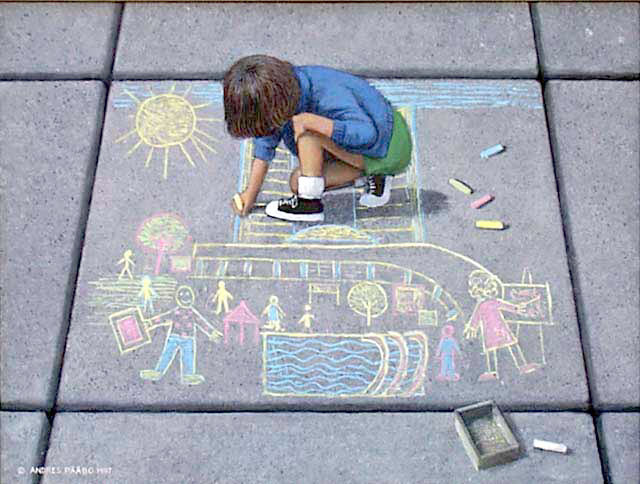
CHALK PAINTING 22"x24"
Inspired
by a tiny photo in a book showing children drawing on a pavement with
chalk, I composed his design inspired by my attendance for several
years of the Toronto Exhibition of Art at Nathan Phillip Square in
Toronto. Nathan Phillip Square is covered with square slabs of
concrete. So my idea was to show a little girl depicting the art
exhibition on one of those squares. I showed the painting at the next
Exhibition but nobody realized the girl was depicting the Exhibition.
One woman, a teacher, wanted it for her school - a number of teachers
had pooled their resources - but her price was very naive. She did not
understand its value had to be comparable to the amount of work in it.
Many naive people establish their idea of cost of art, according to the
common art created with loose brushes, created with little detailed
work, and which take as little as a quarter of the time of detailed
realism. (This painting is still available, but be prepared to bay for
the intriguing concept and detailed work.)
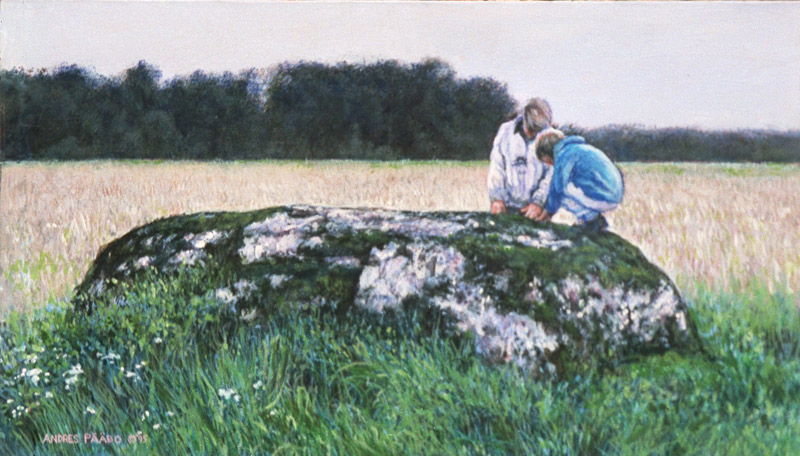 THE ANCIENT ROCK 12" x 20"
I visited Estonia, the country of my
parents origins, in 1993, and was
shown around by my relative. One of the excursions was into the
Estonian farmlands where there are large boulders with man-made pits
put into them. The farming people may have put grains into those pits
to communicate with deities, Such pitted rocks are also found elsewhere
across northern Europe. Here my relative Toivo and his sone are on one
old rock studying the pits.
THE ANCIENT ROCK 12" x 20"
I visited Estonia, the country of my
parents origins, in 1993, and was
shown around by my relative. One of the excursions was into the
Estonian farmlands where there are large boulders with man-made pits
put into them. The farming people may have put grains into those pits
to communicate with deities, Such pitted rocks are also found elsewhere
across northern Europe. Here my relative Toivo and his sone are on one
old rock studying the pits.
In 2009, I believe, wanting to explore paintings
with people, I painted the following painting of a young woman leaning
against a weathered barn/shed. Her environment is one developed by
human hands. The weathered look of the barn, the rust on hinges, also
spoke of it having had a history. It conveys a narrative that is
meaningful to most people. This is a very large painting (48" x
36" compared to the paintings above)
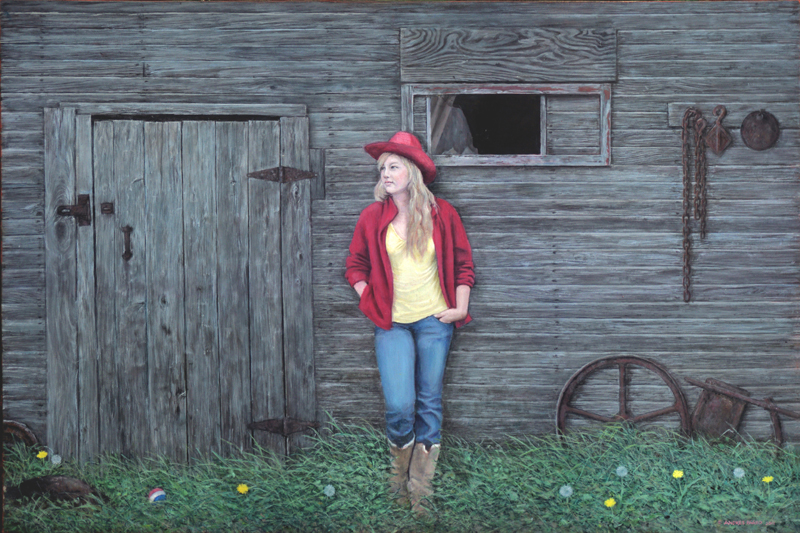
THE RED HAT 48" x 36" oil on canvas
The
barn in the background is based on a real barn/shed, except that in
reality it is a bit twisted. In painting this I made all the
lines horizontal or vertical and the figure postions in the design
involving the door and window. I completed the scene with the rusty
wheel, chains, etc. The grass is made more orderly. It took a long time
to paint for one reason - getting all the boards looking old and
weathered. Based on time spent alone, the painting should be worth at
least $4000 without any dealer commission, shipping, framing.
Another scene which puts a human into a meaningful
context, is the next one. I confess that this painting was inspired by
a photo in a book, and I basically interpreted the content of the
photo. But I show it here anyway:
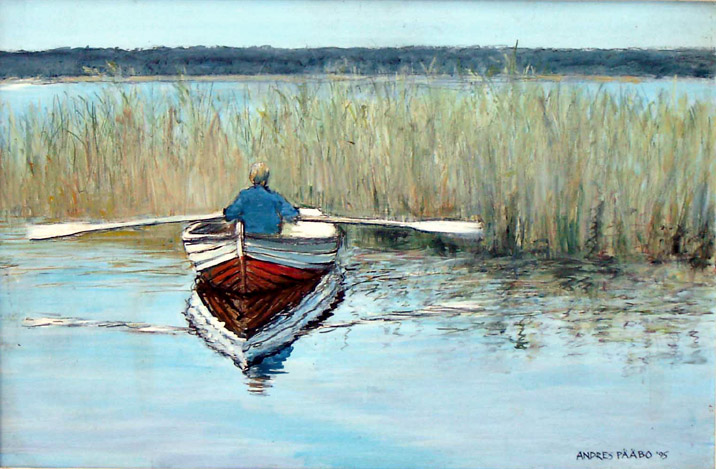
THE ROWBOAT 36" x 24" graphite and acrylics
Inspired
by a photo in an old book, I was fascinated by the reflections in the
water. Although large, I painted this quickly, combining pencil and
acrylics.
4.2 LANDSCAPES WITH HUMANS IN THE
DISTANCE
In my wildlife paintings, I mentioned my practice of
placing suitable wildlife into landscapes when it seemed to improve the
painting, give it more narrative. Well the same can be done with adding
humans to scenes. The humans will be very small in the scene, and the
painting could work without the human figure.
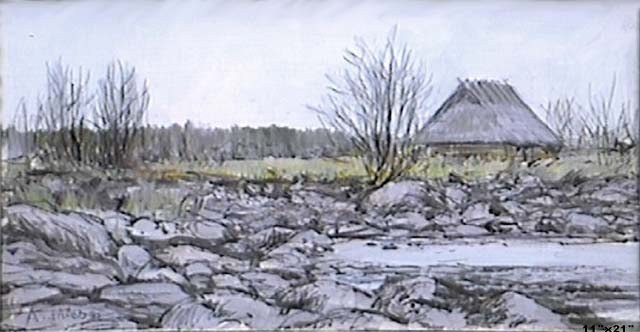
THE HISTORIC BARN ALONG THE SHORE
This
painting was inspired by a photo in a book, depicting places along the
east Baltic shore. As in the previous painting, my job was to interpret
the scene, in this case with plenty of graphite (ie pencil) and only a
little acrylic for colour. You can't see the human? Well the building
suggests the human presence in the scene.
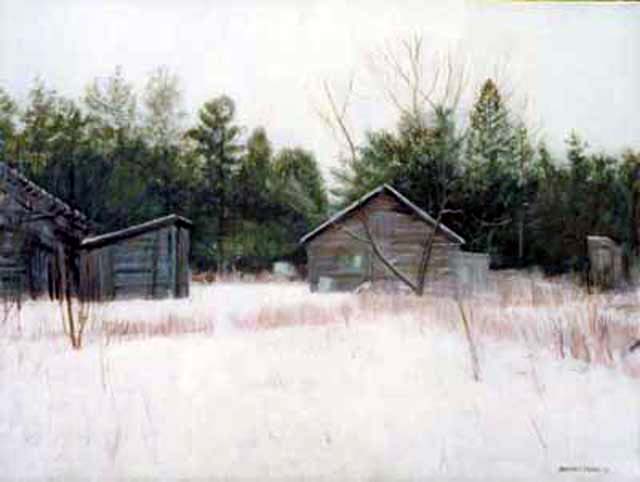 BARNS AND SHEDS OF THE
BUDDS
BARNS AND SHEDS OF THE
BUDDS
For at time the
Budds, some kilometers from me had such barns and sheds, then falling
appart. I painted them at the time. They have all been taken down in
the intevening time and this painting remains as a record of it.
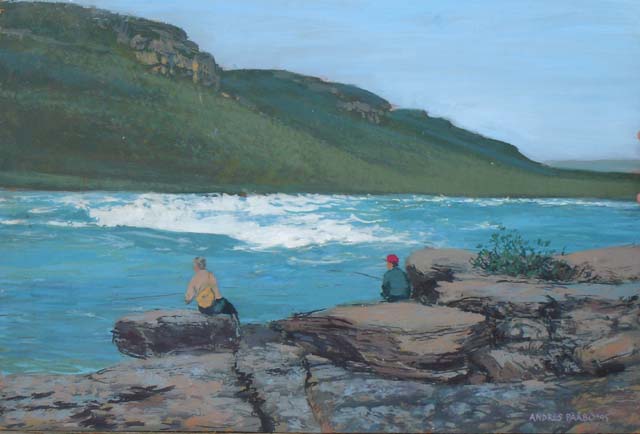 FISHING IN THE ARCTIC
FISHING IN THE ARCTIC
This
is a very quickly painted scene in acrylics, done from a photo from the
Budds, who visited the arctic. As I said above, fishing is a context in
which humans can be found in a natural setting.
The following painting is most like what I would
like to paint - the entire scene is wild nature, but there is a human
in it in a meaningful context. The effect is that it makes us
contemplate the human being as a creature upon the earth - naked rather
than nestled within human altered settings.
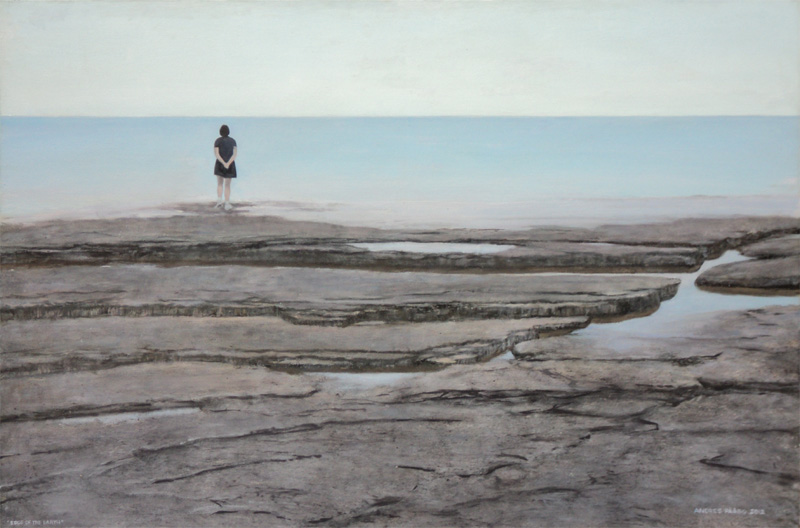
EDGE OF THE EARTH (East shore of the Bruce Peninsula,
facing Lake Huron) 48" x 36"
This is a major
new seriously designed painting from recently, where the human figure,
although small in the context, is a significant element in the
scene/design. This is an actual location that has such flat rocks,
lapped by waves. The figure is contemplating the sea, and the title
'Edge of the Earth' expresses the feeling of standing at the edge of
nothingness.
4.3 PORTRAITURE
In Section 1 and 2, I show my early talent in
portraiture. Traditional portraiture basically places the subject in a
chair, and the background is secondary. It is possible to put wild
nature in the backgound, which I did with the following portrait (The
general problem with photos of faces is that most photos catch the face
in various expressions and not in the most characteristic expression.
If the artist knows the person they know what is the correct resources
and what is not correct.)
Another characteristic of traditional painting is to
be "painterly" which means making the brush strokes, etc stand out.
Painterliness is not good when the objective is to DESCRIBE the subject
matter details as opposed to capturing the feelings of it - as in many
landscapes. Painterliness detracts from the descriptive purpose.
Traditionally, all historic art going back thousands of years, sought
to describe the subject, and it was of utmost importance to make the
painting technique as invisible as possible. The painterliness must not
be the star. The subject is the star.
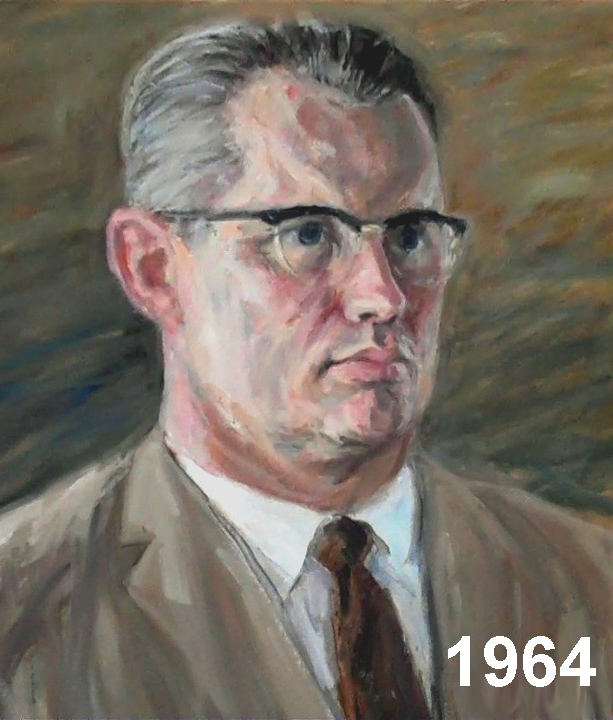 Traditionally, throughout the history of
art, if
the purpose was to portray or illustrate something specific, then it
was of utmost importance to hide the painting technique so that the
technique did not become a barrier to entering the reality portrayed or
illustrated. Imagine for example the Mona Lisa being painted in a
painterly way - the mystery of the Mona Lisa would be lost.
Traditionally, throughout the history of
art, if
the purpose was to portray or illustrate something specific, then it
was of utmost importance to hide the painting technique so that the
technique did not become a barrier to entering the reality portrayed or
illustrated. Imagine for example the Mona Lisa being painted in a
painterly way - the mystery of the Mona Lisa would be lost.
Accordingly all REAL portraits or illustrations I
have created attempt to hide the painting technique unless the purpose
of the painting it to capture emotion. Impressionistic and abstracts
impact on the viewer on the psychological level, and that is fine if
there is no desire to describe anything. But describing the colours and
feathers of a bird, or the features of a face, is more easily achieved
if we make the painting technique invisible. This is clear if we paint
a bird with a few thick brush strokes - it may capture some emotional
qualities in the bird, but it obscures the details - if the purpose is
to portray the details.
While my early paintings followed the tradition of
being painterly - lots of thick brush strokes, I never liked becoming
painterly. I always sought to make the painting about the subject
matter, not my painterliness. My recent portrait and illustrative
paintings try
to hide the painting technique so that the viewer observes the subject
matter BEFORE observing the subject being portrayed. See the next
painting. While you can see the painting technique in it after a few
moments, you do not see it first, but only AFTER seeing the
description of the subject. That is good technique whenever one
portrays a person, animal, or scene needing physical description (ie an
illustrative scene).
(LEFT, ABOVE) A "painterly"
portrait (where the technique dominates) I painted in 1964 when I was
18. Portraits where the technique is strongly demonstrated, is a new
development in art history because before a century ago, the
objective in art was to hide the technique so that attention was entirely on the
subject
The following is a painting from my
recent period (1995-2005), this one of my sister.
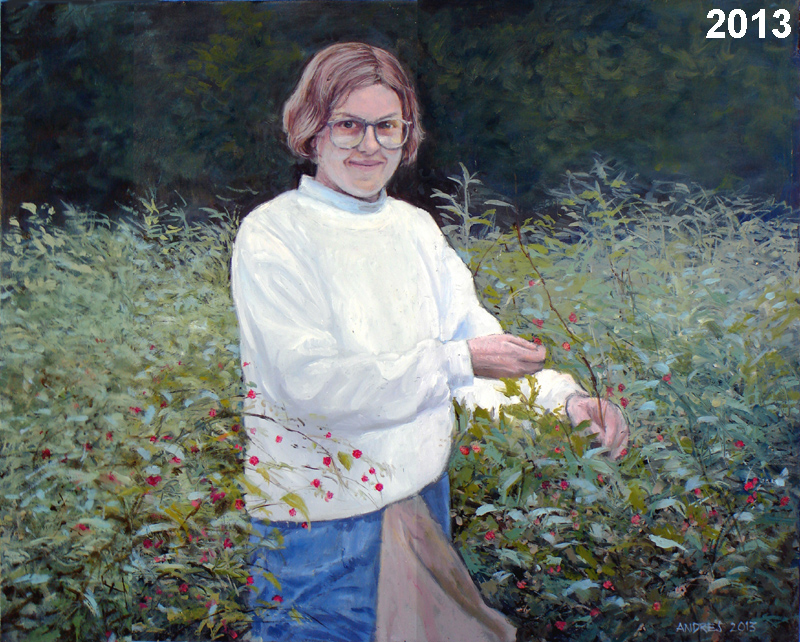
MONICA (about 20"x16")
My
sister Monica came to visit me some years ago, and at the time, wild
raspberries were everywhere, and we went to pick some. It took a few
photos and used them to create the painting. As I said with other
paintings, I CAN work from photos. as long as I know the subjects of
the painting very well at least so that I can detect when something
feels 'correct' compared to my familiarity with it.
It isn't difficult for me to paint a portrait. I
only need a reason for it. Normally a person commissions a portrait
from me, and that is the reason. But one does not always get a good
subject. It is much better when I as the artist can choose my subject
myself - and usually it is when a good idea comes into my head.
The following is one of those portraits which was
not commissioned, but a verbal contract was established that I would
paint a 20 hour painting in exchange for her reading a Young Adult
novel I had just been writing. There is a story connected with this,
and I will present it in a separate article, as it demonstrates the
pitfalls of dealing with people in relation to art.
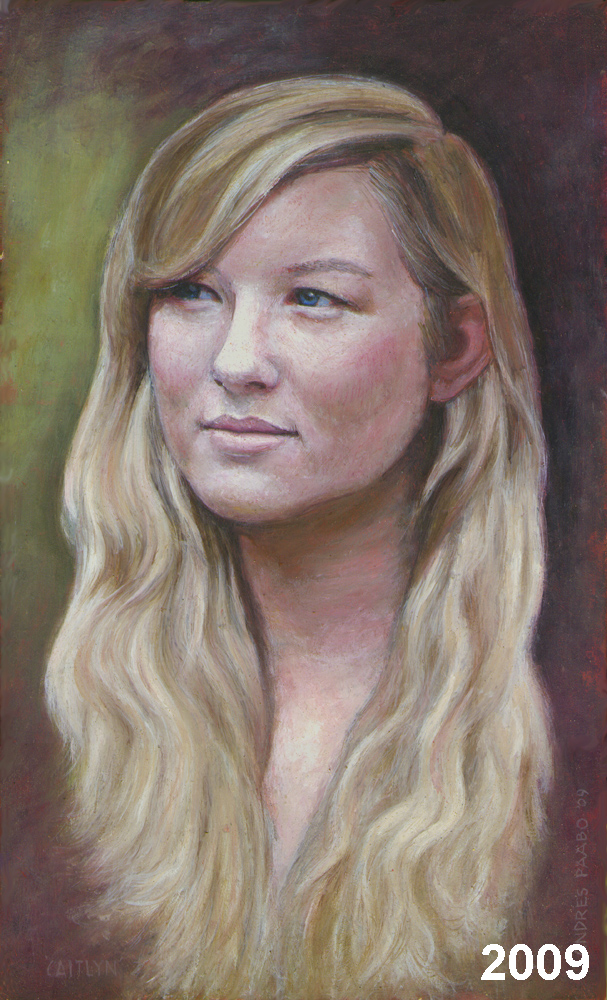
CAITLYN 14"x 8.5"
This painting has a long story attached to
it, but suffice it for me to say that the painting is
unfinished. I made the error of painting it from a photo under warm
light, and that resulted in the painting looking good under lamp light
but looking pale cool under light near a window (window light is cool)
I let her have it temporarily because it needed 6 months to completely
dry before I added a red glaze to correct the overall colour to the
warmer tones. The photo at left has been warmed in Photoshop, but I
need the painting back to correct it with warm glazes..
Also from recent years, is a portrait I did of
artist Micheal Dumas. He was involved with a charitable art show
and sale in Peterborough for which portraits of people of the
Peterborough region was requested. (Putting it up for sale was
optional.) I thought that the above portrait of Caitlyn would fill the
requirements, but he was unable to persuade Cailtyn's mother to let the
charitable show borrow it only. So I suggested to Michael why don't I
paint a portrait of him. He said "okay", so I went to his place to take
a few photos fitting the idea I had in my head. In painting it I
exploited the opportunity of painting it with traditional oil paint,
with only linseed oil and turpentine - same as was done centuries ago.
I also sought to make this a very detailed painting to see if I could
do it - instead of being in a looser more impressionistic technique.
The following is the result. It was hung in the charitable show.
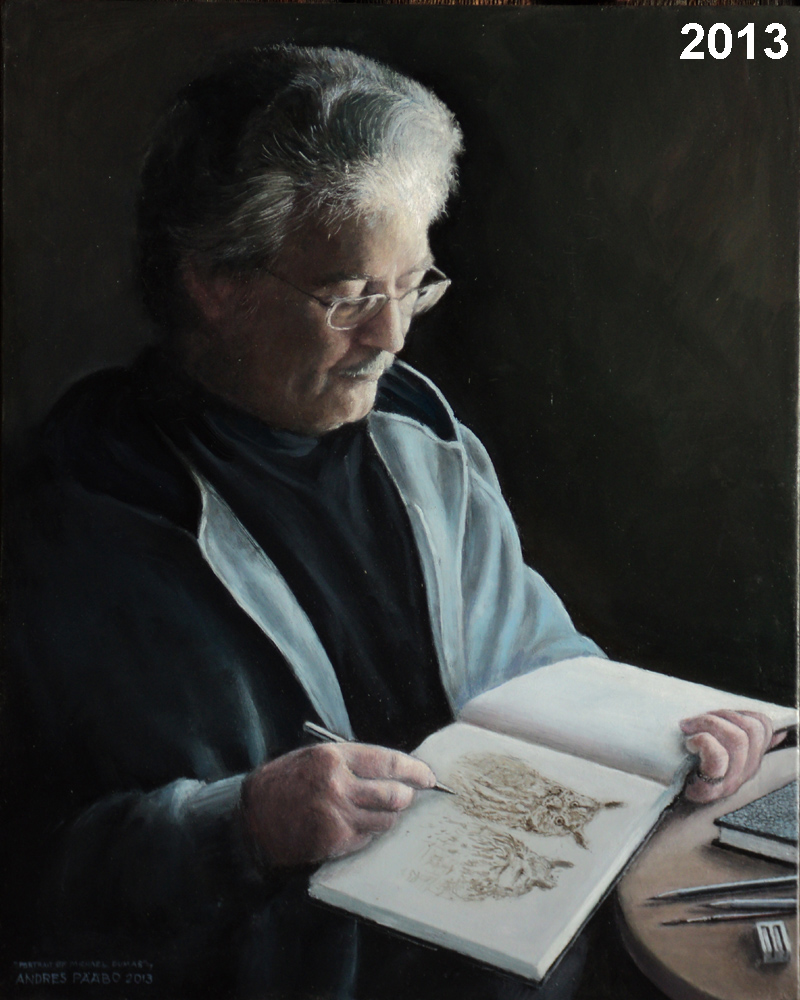
"THE WILDLIFE ARTIST (MICHAEL DUMAS)" - ABOUT
$6,000 BASED
ON TIME SPENT.
Note
the very very high photorealistic technique, with carefully developed
lines to create the overal clean design, including the careful design
of the objects on a round table. Besides my objective of making this a
painting 100% in traditional oil painting technique, on very fine
canvas, I also wanted to give the painting the kind of look of
Micheal's own paintings. Based purely on the great amount of time spent
in design and painting it, I priced it at $6000, but I still face the
lack of understanding of the time and effort needed to create a high
realism painting. I could certainly have painted a loose painting
similar to what I painted decades ago, and priced it under $1000, but
unless my purpose is to make money, I prefer to present myself with
challenges and to go beyond what I have achieved before, even if few
people understand what I have done. I also question painterliness in
any art that is mostly about describing details - portrayals or
illustrations - as opposed to capturing feeling.
4.4 PORTRAITS OF ANIMALS
As with a portrait of a human, a portrait of an
animal is mostly about the animal, and the background is secondary or
even absent. Most of my paintings with animals are mainly landscapes
that include the animal that we would expect in that landscape. In
those paintings, the landscape, the environment, is primary, and the
animal is secondary - often the viewer not seeing it and suddenly being
surprised to see it.
But now and then I wanted to portray an animal -
usually when I got to know the animal well, from seeing it often in my
daily experience - like chipmunks and red squirrels - or from extensive
research of videos, etc - such as my mastery of wolves.
The human is just another animal, so my experience
portraying humans, is transferable to portraying non-human animals.The
following are some obvious portraits of animals - the animal dominating.
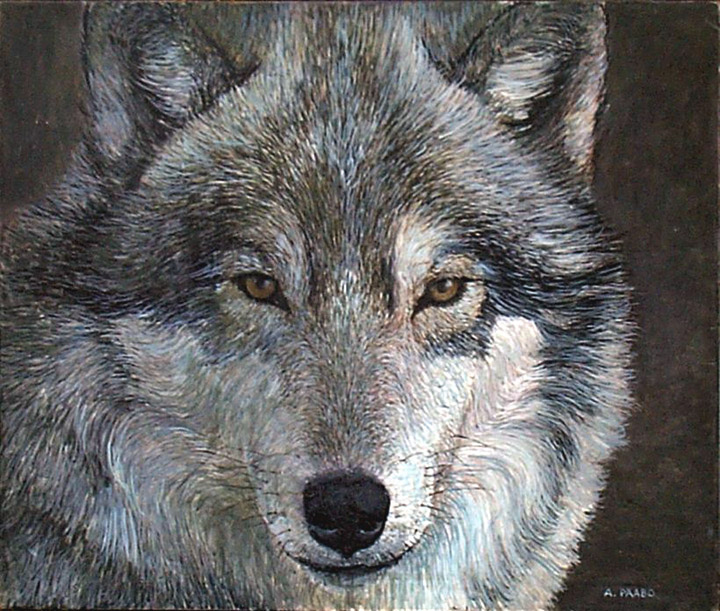 STUDY OF WOLF FACE 24"x24"
All wolves have the same pattern of
fur on their face, and hints of the coloration patterns. It is because
we recognize it in dogs, that a wolf can look attractive like a
short-eared large dog.
STUDY OF WOLF FACE 24"x24"
All wolves have the same pattern of
fur on their face, and hints of the coloration patterns. It is because
we recognize it in dogs, that a wolf can look attractive like a
short-eared large dog.
TUNDRA SPRING - WHITE-THROATED GOOSE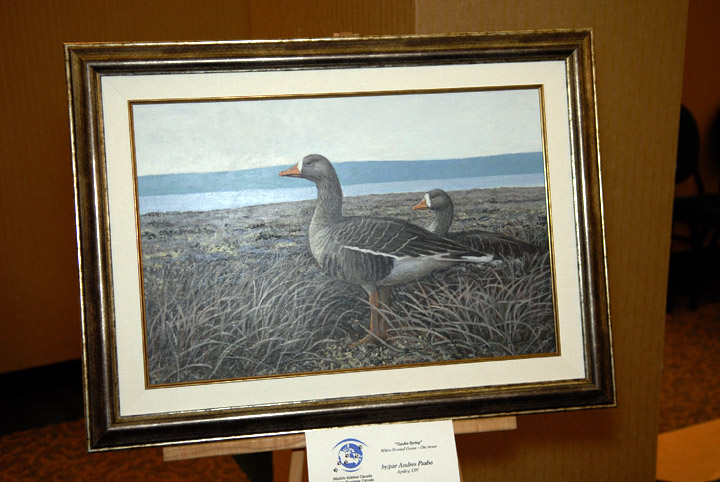
These
goose winter in southern Europe or southern North America, and winter
either in the Canadian arctic of arctic islands of Europe. Some believe
they are ancestral to the common farmyard goose. I do not know these
birds. I researched them through internet pictures, and developed it as
it was one of the birds suggested as the subject in a Habitat Canada
wildlife art competition. This painting was one of the top three and
shown off in Ottawa, but of course I would have preferred to win.
(RIGHT)ONE OF TOP THREE IN THE HABITAT CANADA COMPETITION
>>
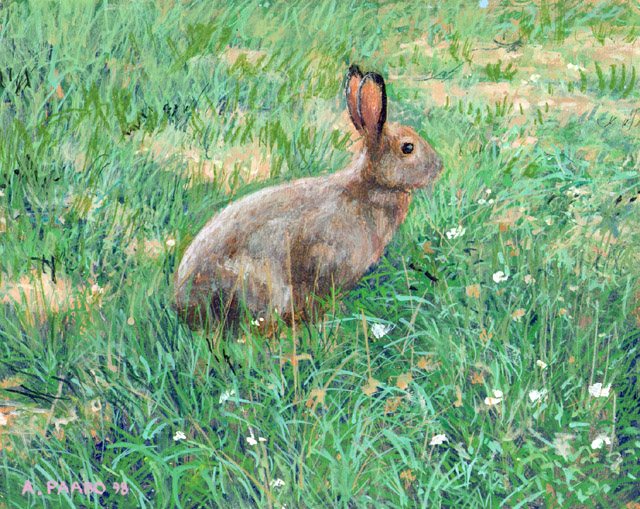
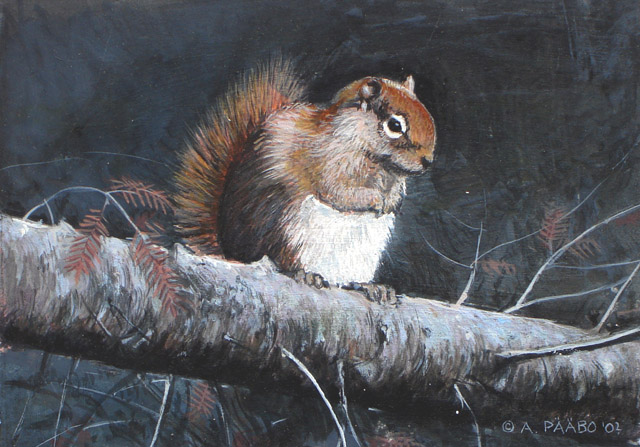 SNOWSHOE HARE ..... RED SQUIRREL
SNOWSHOE HARE ..... RED SQUIRREL
Both the snowshoe hare and red squirrel are frequent visitors to my
property, and it was easy to make portraits of them
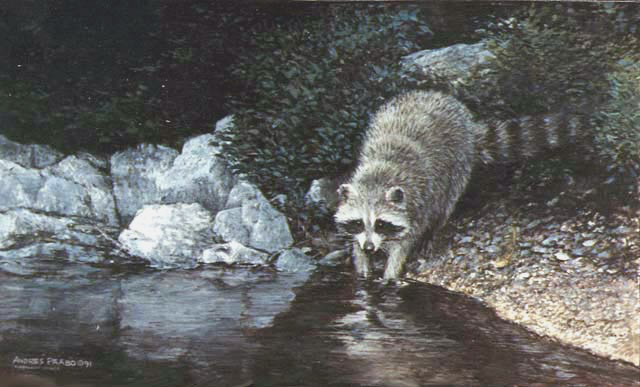
RACCOON BY THE SHORE
The
raccoon is another common visitor to my property, following the shore,
so when I had an interesting piece of shore, it was interesting to
install the racoon in it.
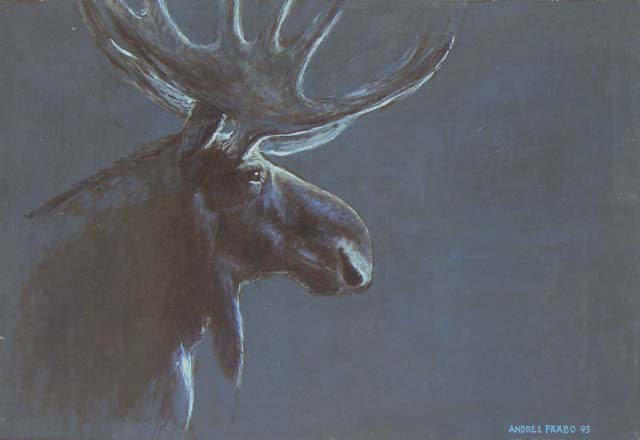
MOOSE PROFILE
This is one of several profile portraits in which I had the light
define the edges instead of drawing any lines.
IMPRESSING THE LADIES
There are also wild turkeys in my area. Even if I didn't manage to get
very close to them, the very fact they were in my environment inspired
me to portray them. Actually this was painted in response to a
competition by the Ontario Ministry of Natural Resources, which called
for a depiction of wild turkeys to suit a wallet-size "conservation
card". I was told mine was one of the finalists, but the trouble is
that these competitions give absolutely nothing if you do not win - not
even any publication of finalists or any publicity. That is why I
ceased to enter such competitions. This painting is available.
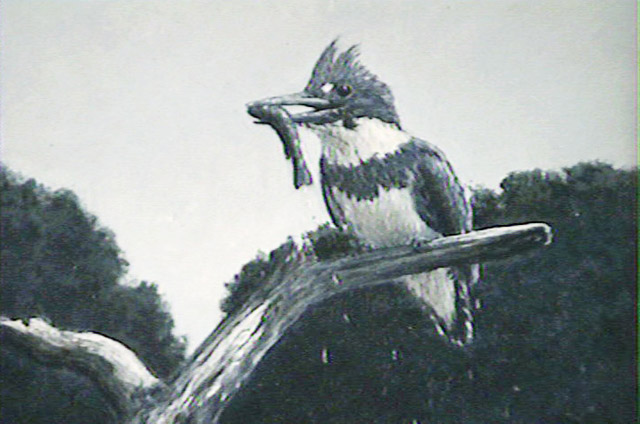
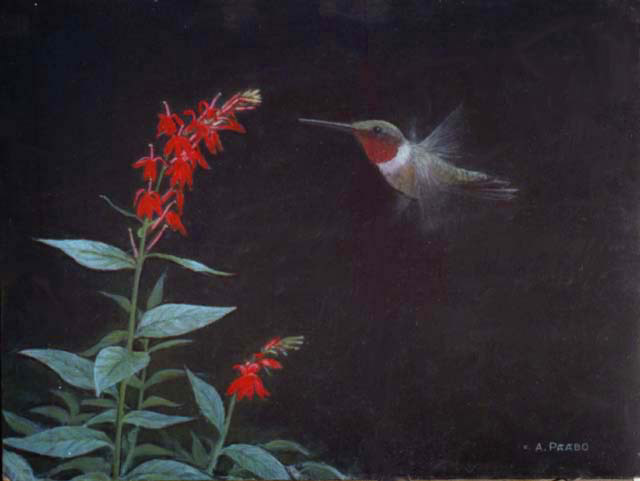 KINGFISHER ......HUMMINGBIRD AND CARDINAL FLOWERS
KINGFISHER ......HUMMINGBIRD AND CARDINAL FLOWERS
These
are another couple of animals I see often. One is inspired if one
already knows the animals. One knows their character, their behaviour
and what to portray.
LOONYBACKING
The
loon is also common in my area, visiting my bay daily in the summer. It
gave me plenty of opportunity to view them through binoculars. In this
painting, I used the design in the water to give a sense of the loon
being at one with the water.
EYE OF THE WOLF
In
my research and painting of wolves, I was fascinated how the stare of a
wolf's eye is chilling. I therefore got the idea of focussing on the
eye of one side of the face, lit by moonlight, and the other eye in the
shadow.
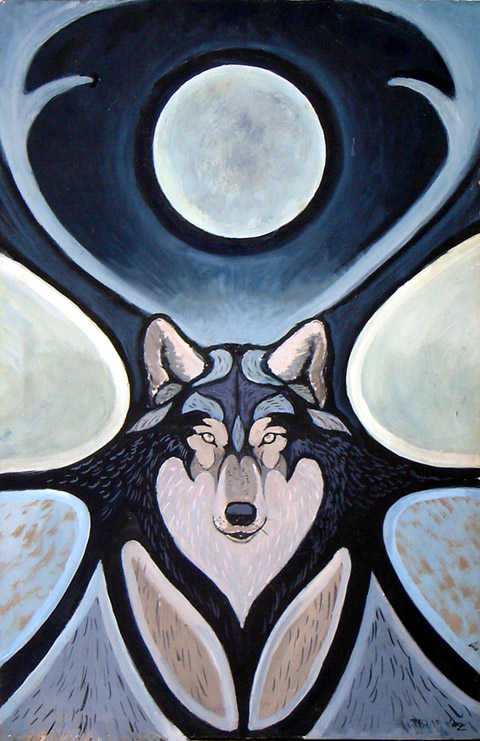
WOLF DESIGN
I
was inspired by graphics of animals in Native art, to try something
like that myself. Here the circle is the moon, and the curves around it
suggest antlers of caribou, and the wolf is closely tied to the caribou
as prey, in northern Canada.
4.5 HISTORIC ILLUSTRATIVE MASTERPIECES
ARE AN INSPIRATION
Several years ago, I was fortunate enough to
visit Montreal where the touring show of the paintings of Waterhouse
were on display. Waterhouse is the artist that poster-makers like to
print and sell, since they are illustrative and convert to reproduction
form readily.
I am in love with such historic masterpieces,
because they transcend normal illustration in ambitiousness and glory.
Circumstances existed that made it feasible for an artist to spend a
year or years on a single large painting or mural, reaching a result
beyond the average. Such masterpieces were commissioned by wealthy
families for their expensive manor or castles. The tradition of large
illustrative, story-telling, paintings - usually frescos - dates back
to ancient Greece and Rome. The following panel shows the painting of
the birth of Venus/Aphrodite in mythology found at the Roman city of
Pompeii along with many other large murals. They loved murals.

The
photo to the right is located in the ruins - as made available to
tourists - of the ancient Roman city of Pompeii (the one that was
destroyed by the nearby volcano).
The painting you see is one of
the original depictions of the Birth of Venus, but even this is not the
first, but copies one painted centuries earlier by an artist named
Apelles, as Roman historian Pliny reported. It shows Venus/Aphrodite
lying in an enormous shell floating in the sea surrounded by Cupid and
other figures. In any event Pompeii
presents numerous large mural paintings showing how in vogue it was in
ancient times to paint large illustrative murals
|
The subject of the Birth of Venus was repeated not
just in classical times, but when the European Renaissance arrived,
when there was a revival of ancient classical science and culture,
Boticelli was commissioned to paint the subject again, as shown in the
panel below. Because of the fame of Botelli's painting, other artists
through European art history tried their own versions of the subject,
but none was as good as this one.
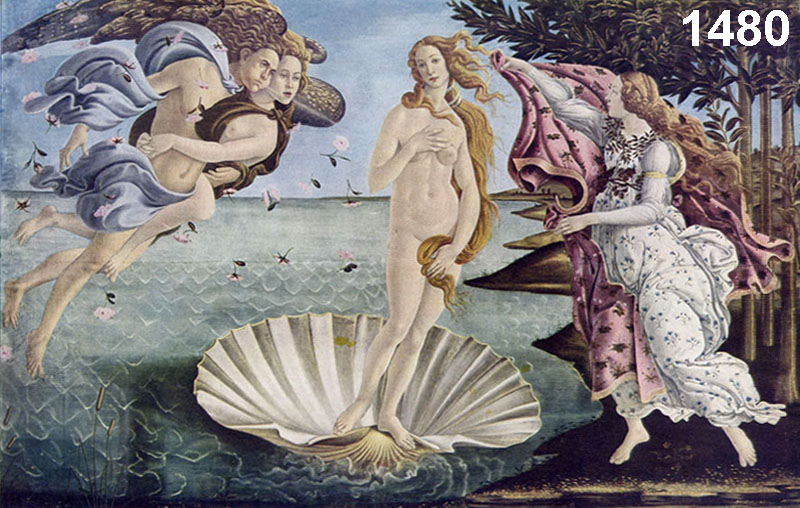
Botticelli's
"THE BIRTH OF VENUS" painted in 1480, based on Greek mythology, is
probably the most famous muralic masterpiece of the last couple of
millenia, achieved only because in those times wealthy families or the
Church might hire an artist to spend years to create such works.
(Another famous illustrative masterpiece is Leonardo Da Vinci's 'The
Last Supper"
|
But the Birth of Venus is only one of many subjects from
the Bible or ancient Greco-Roman mythology, that were illustrated in
elaborate, large, adventurous paintings. The last of this tradition
occurred in the late Victorian era. Personally I found the artist JW
Waterhouse one of the most impressive. He used themes from the Greek
epic Odyssey, and then stories from the mythology of King Arthur
covered by poet Tennyson. The following panel shows his most
famous painting - The Lady of Shallot, painted in 1888.
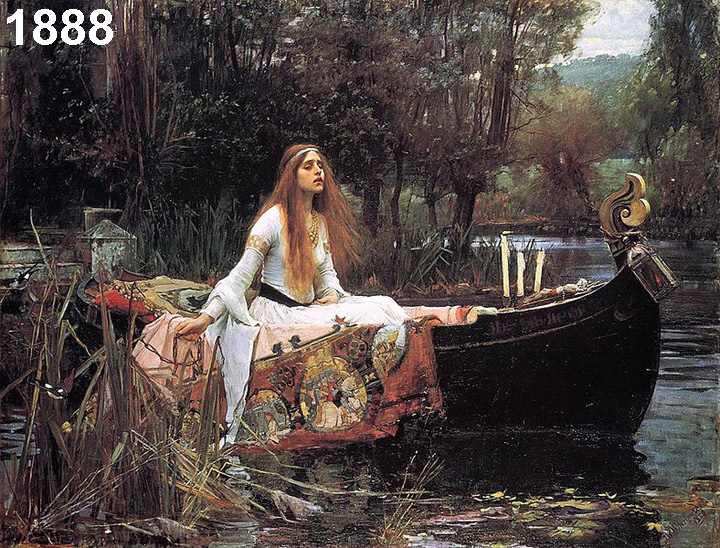
LADY OF SHALOTT
by JW Waterhouse
Example of the most recent
pursuit of large illustrative mural-paintings celebrating something
high in the public consciousness.
In the Victorian era, large storytelling murals were the rage, and
toured museums. This painting is one of the more famous ones. What
caused the art world to decide to paint crap and call it art after
three millenia of real art?
|
Today there are artists creating illustrations
for
books, movie posters, etc. But they all fall short of what can be
achieved if there is financial support for an artist taking a year or
years achieving something incredible. (Obviously the artist has to be
good to begin with; otherwise a large amount of time will not make
their work better in quality.) Also, there is no practice any longer of
putting large murals onto walls. Corporations - who have the money to
afford major works - no longer think of commissioning a stunning mural.
My closest attempt to create a storytelling
mural-type painting was my 6ft by 4ft "Under Northern Skies" shown
below. It wasn't commissioned. I simply felt that this painting would
have maximum impact if it was large so I could have an environmental
effect from the dramatic sky. So I painted it large, and I still have
it because ordinary people do not have large walls. It needs a large
wall, such as in a large lobby of a public building. I have to start
making contacts to find a home for it.
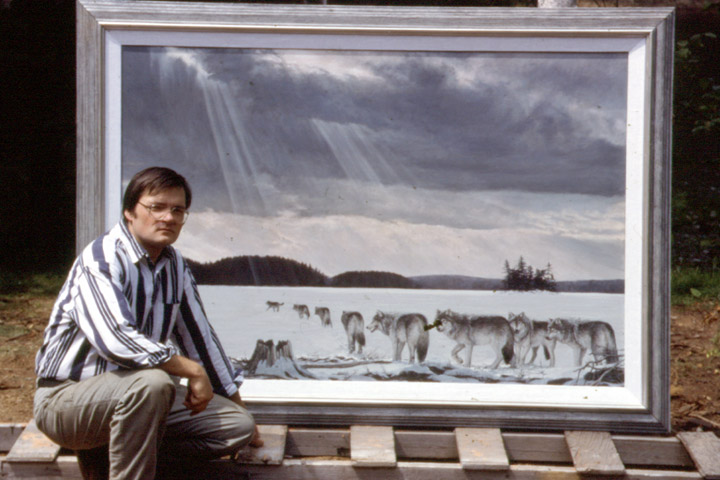 .
.
My largest painting
UNDER
NORTHERN SKIES
I
created this painting so large because I wanted to dramatize the sky.
But today there is no market for paintings this large.
VISIT TO THE JW WATERHOUSE EXHIBITION IN MONTREAL
I was informed of a world touring show of the work
of John William Waterhouse visiting Montreal in early 2010, and I
wanted to see it. I had already become interested in including humans
in my paintings, considering I had already been painting humans in
portraits. I had yet to properly portray humans in a larger context, in
an environment of some kind - except the painting shown above called
"Red Hat" with the young woman standing in front of a barn/shed.
But in the late Victorian era, the paintings were
much more involving, much more elaborate, and filled with so much
detail that a person would have to sit in front of it for an hour to
take everything in. That is extraordinary, and something not found
since. 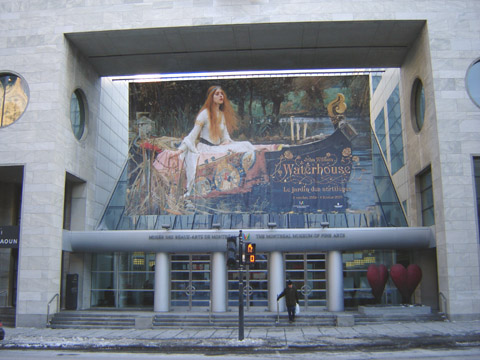 In
those days - before photography - the profession of artist was
a distinguished and celebrated profession, much like architect today.
The artist went through many years of formal study, and there were art
academies governing the profession.
In
those days - before photography - the profession of artist was
a distinguished and celebrated profession, much like architect today.
The artist went through many years of formal study, and there were art
academies governing the profession.
I
therefore arranged tickets to take the earliest train to Montreal in
the morning, see the exhibition, and then return by the late train. It
was quite an endeavour, but I achieved what I intended - without the
need to linger in Montreal overnight. It was located in the MUSEE DE
BEAUX ARTES - MUSEUM OF FINE ARTS. A banner of Waterhouse's Lady of
Shallot was stretched above the entrance (see photo)
I was surpised how moving the original paintings
were - each seemed to have an intangible energy. The exhibition was
very powerful. When afterward I made a quick tour of the art museum
where the exhibition was held, it was anti-climactic.
Photography was not permitted in the exhibition, so
I can only show some of the major images obtained from the internet.
Some of the images have been reproduced as posters recently and you
will find them familiar.
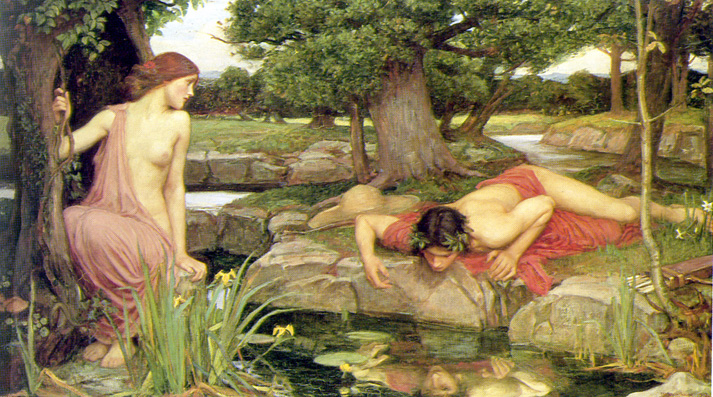
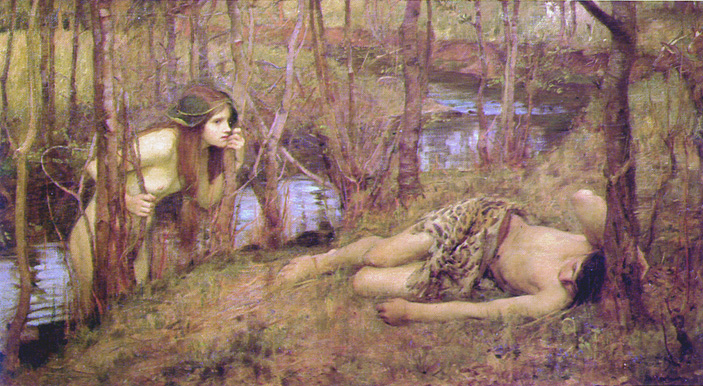
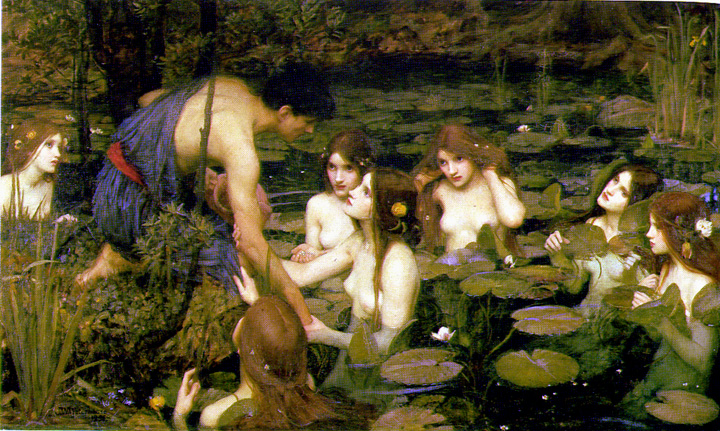
Three of the major paintings by JW
Waterhouse done over a century ago and shown in the touring exhibition
I have only shown three of the most significant,
most elaborate
paintings, but you can see what I am talking about. They all illustrate
some scene from mythology. He was mostly interested in events in the
Odyssey and the legends of King Arthur as described poetically by
Tennyson.
Although I have not embarked on any new project yet,
or at least finished any, I am keen to paint narratives that illustrate
something important in our culture today. ALWAYS, art mirrors what
society of the time celebrates. In Waterhouse time, the Odyssey - the
adventures of Ulysses - were strong in British culture, as was the
stories of King Arthur described by Tennyson. This was a time when
students learned Latin and Greek in school, as well as Greek mythology
on the one hand, and celebrated poetry and poets on the other.
Thus obviously any illustrative work today must
reflect today's popular thinking. As I already said above, the art that
illustrated wildlife in their habitat was a response to society's
growing interest in the natural environment, concern about pollution,
concern about endangered species. So that theme is still valid. But if
we include people in such paintings, what role would they play and in
what context.? I suppose there is a great interest in health and
fitness. It is a question needing more thought. One could go
negative, such as paintings showing clearcut forests or polluted
waters, but negative paintings only have a moment of shock value:
people do not want to continue to look at them and disturb their life.
It has always been better - as wildlife artists did - to show the
opposite: animals in absolutely pristine environments do that the
negative comes from their actual daily life.
In any event, at this stage - being semi-retired - I
now have some freedom taking on major projects that last years, instead
having to churn out saleable little paintings or prints to make a
living. And that is where I am now, in 2016. WATCH FOR DEVELOPMENTS.
written
April 2016
by the artist - Andres Paabo
contact: A.Paabo, Box 478,
Apsley, Ont., Canada
2016 (c) A. P��bo.
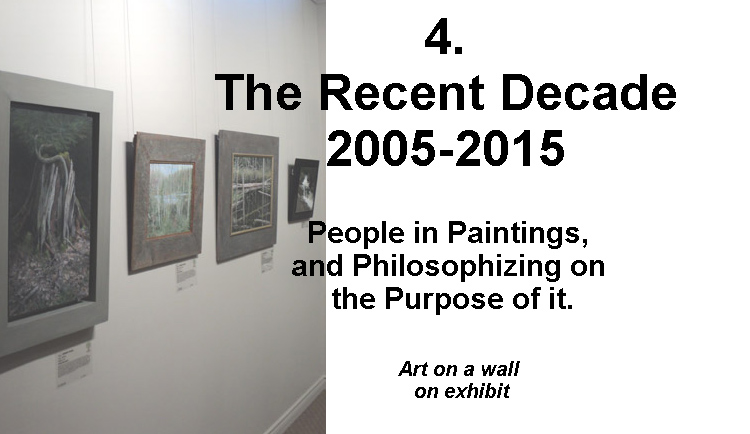






 BARNS AND SHEDS OF THE
BUDDS
BARNS AND SHEDS OF THE
BUDDS
 FISHING IN THE ARCTIC
FISHING IN THE ARCTIC

 Traditionally, throughout the history of
art, if
the purpose was to portray or illustrate something specific, then it
was of utmost importance to hide the painting technique so that the
technique did not become a barrier to entering the reality portrayed or
illustrated. Imagine for example the Mona Lisa being painted in a
painterly way - the mystery of the Mona Lisa would be lost.
Traditionally, throughout the history of
art, if
the purpose was to portray or illustrate something specific, then it
was of utmost importance to hide the painting technique so that the
technique did not become a barrier to entering the reality portrayed or
illustrated. Imagine for example the Mona Lisa being painted in a
painterly way - the mystery of the Mona Lisa would be lost.


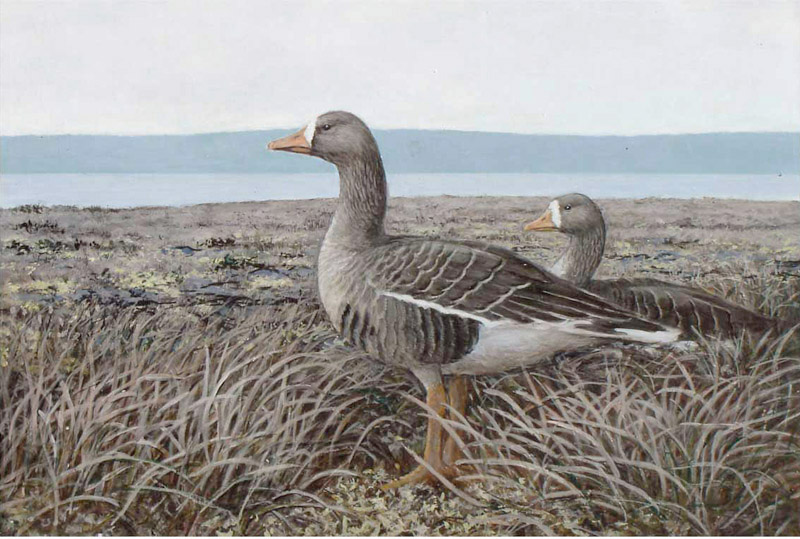


 SNOWSHOE HARE ..... RED SQUIRREL
SNOWSHOE HARE ..... RED SQUIRREL


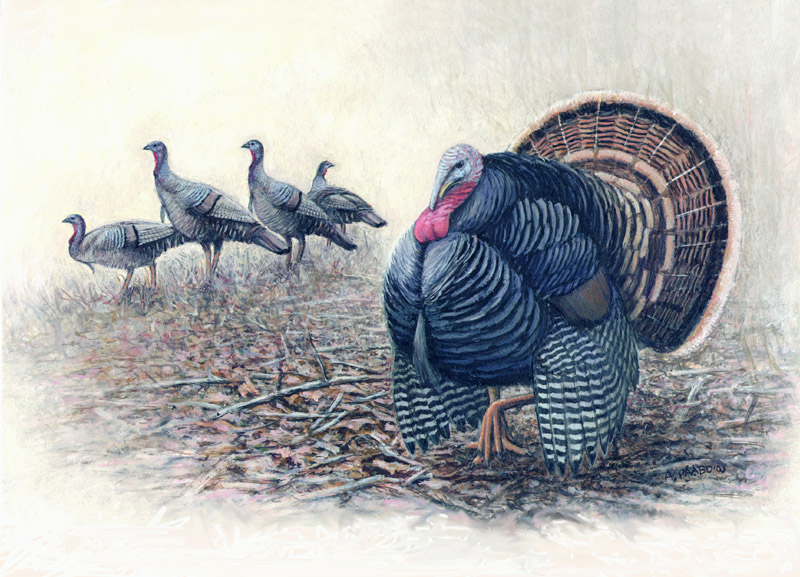

 KINGFISHER ......HUMMINGBIRD AND CARDINAL FLOWERS
KINGFISHER ......HUMMINGBIRD AND CARDINAL FLOWERS
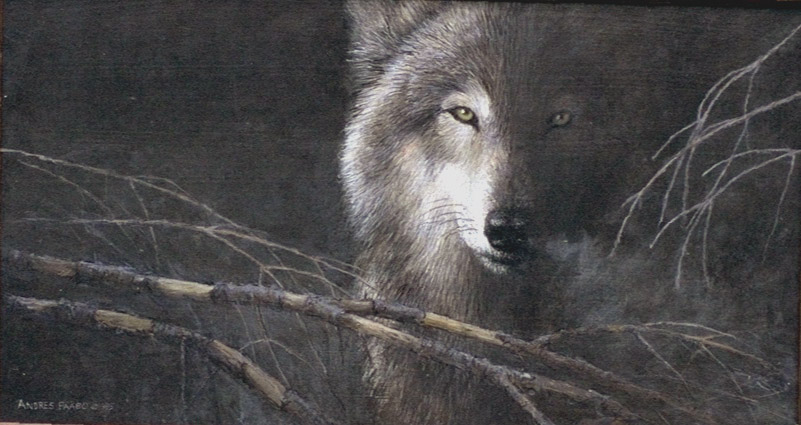




 In
those days - before photography - the profession of artist was
a distinguished and celebrated profession, much like architect today.
The artist went through many years of formal study, and there were art
academies governing the profession.
In
those days - before photography - the profession of artist was
a distinguished and celebrated profession, much like architect today.
The artist went through many years of formal study, and there were art
academies governing the profession.

